Market Trends of Urinary Incontinence Treatment Devices Industry
Urethral Slings Segment Expected to Witness Healthy Growth Over the Forecast Period
Urethral slings surgery is also known as mid-urethral sling surgery. The sling material used may be muscle, ligament, or tendon tissue. It may also be composed of synthetic material, such as plastic compatible with body tissues, or absorbable polymer that disintegrates over time. The urethral slings segment is expected to witness growth as these are highly recommended for surgical treatment for the treatment of stress urinary incontinence. Factors such as the rising prevalence of urinary incontinence, rising geriatric populations, and increasing developments by key market players are expected to boost segment growth.
According to an article published by PubMed Central in December 2022, a study was conducted in UAE which showed that the quality of life was affected in an estimated 90% of the patients suffering from urinary incontinence. Thus, the rising burden of urinary incontinence among women and the aging population is boosting the demand for urethral slings.
Furthermore, according to an article published by PubMed in January 2021, a study was conducted in Argentina which showed that there is a high prevalence of stress urinary incontinence among Argentinian women. The article also stated that among the patients who were having stress urinary incontinence, the prevalence of uncomplicated stress urinary incontinence was 39%. Thus, the high burden of urinary incontinence in the country is expected to boost the adoption of urethral sling.
Moreover, according to the data updated by WHO in October 2022, it is estimated that by 2030, 1 in 6 people around the world will be aged 60 years or over, and the share of the population aged 60 years and over will increase from 1 billion in 2020 to 1.4 billion in 2030, and by 2050, the world's population of people aged 60 years and older will double to 2.1 billion. It is also estimated that the number of persons aged 80 years or older is expected to triple between 2020 and 2050 to reach 426 million. As the geriatric population is often associated with urinary incontinence, the rising geriatric population is expected to boost market growth.
Thus, the aforementioned factors such as the rising prevalence of urinary incotinence, and the rising geriatric population are expected to boost the studied segment growth.

North America Expected to Hold a Significant Market Share over the Forecast Period
The major factors driving the market growth in the North American region are increases in the prevalence of urinary incontinence (UI), the geriatric population, and the demand for minimally invasive surgeries in the region.
For instance, according to an article updated by NCBI in August 2022, it is estimated that approximately 13 million Americans experience urinary incontinence annually, and the prevalence is 50% or greater among residents of nursing facilities. Similarly, according to an article published by Taylor & Francis Online in February 2023, a study was conducted in Mexico which examined the relationship between gender and the different urinary incontinence subtypes in community residents of the country in people aged 50 years old and above, it was found that in elderly females, mixed urinary incontinence had the highest incidence rate of 8.7%, which increased with age from 6.9% in 50 to 59-year-olds to 11.8% in 90 year olds. Thus, the high prevalence of urinary incontinence is expected to boost the market growth in the region.
Moreover, the rising geriatric population is also a major factor in market growth. For instance, according to the data published by Statistics Canada in July 2022, it is estimated that around 7,330,605 people are 65 years of age or older in Canada, which accounts for 18.8% of the total population.
Strategies adopted by major companies, such as research and development, mergers and acquisitions, and product launches to strengthen their market position are other driving factors for the growth of the market studied. For instance, in April 2021, Medtronic announced that they have gained approval from the United States FDA to proceed with an investigational device exemption (IDE) trial to evaluate its internally-developed, implantable tibial neuromodulation (TNM) device, which is designed to provide relief from symptoms of bladder incontinence.
Therefore, these aforementioned factors such as the rising prevalence of urinary incontinence, the rising geriatric population, and the increasing developments by key market players are expected to boost the urinary incontinence treatment devices market in the region over the forecast period.

